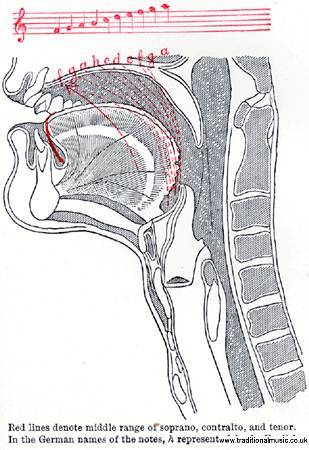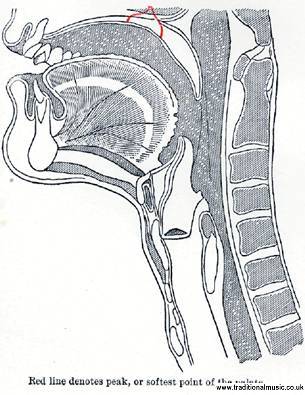SECTION X
SENSATION AND POSITION OF THE TONGUE
We feel the placing of its tip against or
beneath the front teeth; and place the tip
very low, so that it really curves over in
front. (See plate.)
Its hinder part must be drawn back
toward the palate, in the pronunciation of
every letter.
Furthermore, by looking in the mirror we
can see that the sides of the tongue are raised
as soon as we wish to form a furrow in it;
that is, as we must do to produce the pala-
tal resonance. (Only in the head tone — that
is, the use of the resonance of the head cav-
ities without the added palatal resonance —
has the tongue no furrow; it must, however,
lie very high, since otherwise its mass, when
it lies flat, presses against the larynx and
100 HOW TO SING
produces pinched or otherwise disagreeable
tones.)
The best way is to get the mass of the
tongue out of the way by forming the furrow
in it. In high notes, when the larynx must
stand as high as possible, the back of the
tongue also must stand very high; but since
there is a limit to this, we are often compelled
to make the larynx take a lower position.

The correct position of the tongue, prepar-
atory to singing, is gained by saying the
vowel sound aou, as if about to yawn.
The tongue must not scrape around up-
ward with its tip. As soon as the tip has
been employed in the pronunciation of the
consonants I, n, s, t, and z, in which its ser-
vice is very short and sharp, it must return
to its former position, and keep to it.
POSITION OF THE TONGUE 101
It is best to watch the movements of the
tongue in the mirror until we have formed
the correct habit permanently. The more
elastic the tongue is in preparing the form for
the breath to pass through, the stiller will it
appear, the stiller will it feel to us. It is
well, however, for a considerable time to
watch in a mirror all functions of the organs
that can be seen; the expression of the face,
the position of the mouth, and the movement
of the lips.
SECTION XI
THE SENSATIONS OF THE PALATE
The sensations of the palate are best made
clear to us by raising the softest part behind
the nose. This part is situated very far back.
Try touching it carefully with the finger.
This little part is of immeasurable importance
to the singer. By raising it the entire
resonance of the head cavities is brought into
play — consequently the head tones are pro-
duced. When it is raised, the pillars of the
fauces are lowered. In its normal position
it allows the pillars to be distended and to
close the head cavities off from the throat, in
order to produce the chest tones; that is, to
permit the breath to make fullest use of the
palatal resonance. As soon as the soft pal-
ate is lowered under the nose, it makes a
point of resonance for the middle range of
102
THE SENSATIONS OF THE PALATE 107
voice, by permitting the overtones to resound
at the same time in the nose. (See plate,
middle range.)
Thus the palate performs the whole work
so far as concerns the different resonances,
which can be united and separated by it, but
must always work together in close relation,
always bound together in all tones, in all
hinds of voices.
The lowest chest tones of the bass, the
highest head tones of the soprano, are thus
the two poles between which the entire
gamut of all voices can be formed. From
this it can be perceived that with a certain
degree of skill and willingness to work, every
voice will be capable of great extension. | 

